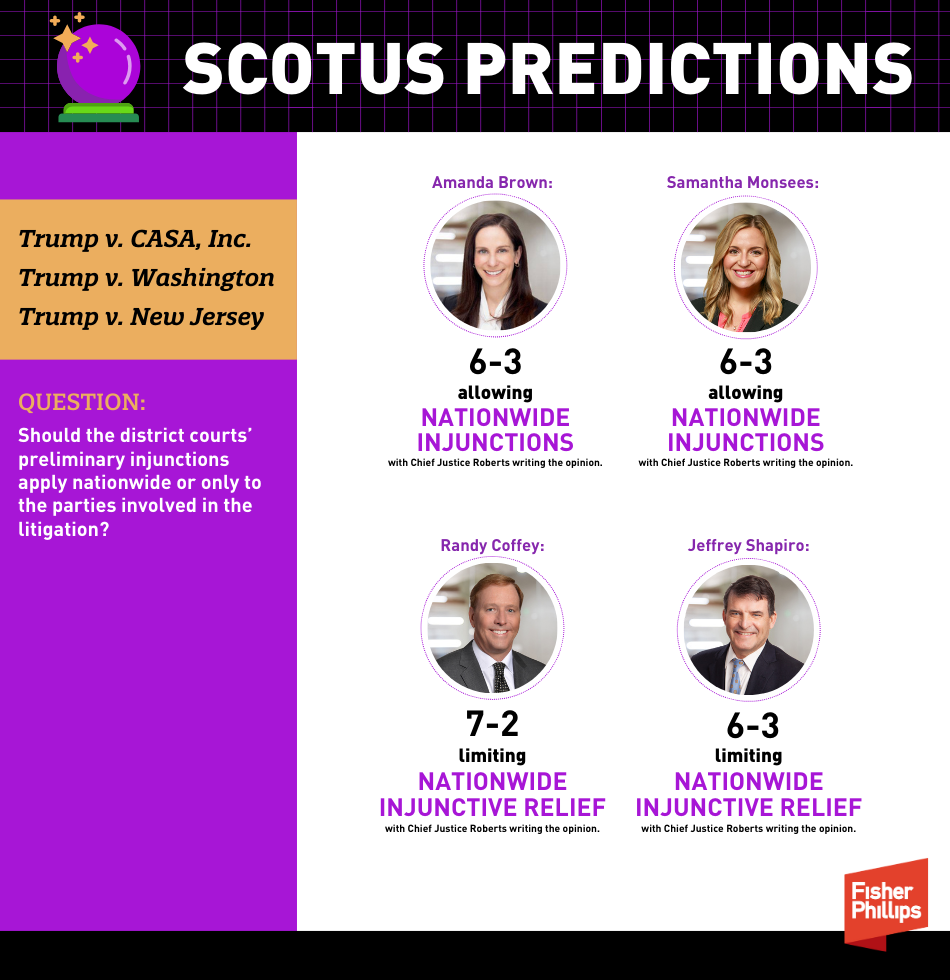SCOTUS Will Soon Decide If Federal Judges Can Issue Nationwide Injunctions: What's at Stake for Employers?
Insights
5.09.25
The U.S. Supreme Court is poised to decide a landmark case that could significantly limit the ability of federal judges to issue nationwide injunctions – a move that could have a profound impact on the workplace. Injunctions are court orders that tell the parties to either start or stop doing something, and when issued nationwide, they have stalled employment policy for both Republican and Democrat administrations over the last decade. While the underlying case concerns the Trump administration’s move to eliminate the Fourteenth Amendment right to birthright citizenship, the Supreme Court has been asked to decide only whether federal district courts have the power to issue nationwide injunctions blocking the executive order while the lawsuits are pending. The ruling could carry broad implications, especially for employers who’ve been caught in the crossfire of sweeping federal policies halted (or enforced) through coast-to-coast injunctions over the past decade. Here’s what you need to know – and our predictions on how SCOTUS will rule.
Why This Case Matters to Employers
The case, set for oral argument on May 15, stems from three nationwide injunctions issued by federal judges blocking one of the Trump administration’s latest executive orders (Trump v. CASA, Inc., Trump v. Washington, Trump v. New Jersey). The Trump administration has used this case as a vehicle to ask the Supreme Court to limit the reach of any injunctive relief entered by federal district courts to the specific plaintiffs in each individual case.
If the Court agrees with the Trump administration and grants the request to limit the use of nationwide injunctions, it could fundamentally reshape the legal options available in major regulatory battles – this includes both executive orders and regulations issued by federal agencies like the Equal Employment Opportunity Commission (EEOC), the Department of Labor (USDOL), the National Labor Relations Board (NLRB), and other agencies.
|
For employers, this would mean:
|
A Decade of Disruption: How Nationwide Injunctions Have Shaped the Workplace
Nationwide injunctions have been a defining feature of modern workplace regulation. Whether employers supported or opposed a particular policy, the eleventh-hour nature of some of these injunctions caused compliance headaches. But at least the certainty they afforded allowed companies to feel comfortable with the outcome and plan accordingly, especially if they have multistate operations. Here’s a look at the major employment-related rules and actions impacted by nationwide injunctions in recent years:
- Overtime Rule 1.0 (2016): A Texas district court issued a nationwide injunction blocking the Obama-era rule that would have doubled the salary threshold for white-collar overtime exemptions.
- EEO-1 Component 2 Pay Data Reporting (2019): A federal court ordered the Trump EEOC to reinstate expanded EEO-1 reporting requirements, including employee pay data by race and gender.
- Public Charge Rule (2019–2021): Several nationwide injunctions stopped the Trump administration’s immigration changes that would have made it harder for foreign nationals to obtain work visas and green cards – policies with direct implications for employers relying on foreign talent.
- Joint Employer Standards (2020): Nationwide orders vacated Trump-era changes to the USDOL’s joint employer rule, reintroducing uncertainty for franchise and staffing businesses.
- Union Election Rules (2020–2022): Federal courts temporarily blocked the Trump administration’s rules that streamlined union elections, preserving more union-friendly Obama-era procedures.
- COVID-19 Vaccine Mandates (2021): Federal courts issued nationwide blocks against the Biden administration’s OSHA emergency temporary standard (ETS) that aimed to require vaccination or testing for large employers.
- FTC Non-Compete Ban (2024): Employer groups secured early nationwide injunctions in multiple circuits challenging the Biden FTC’s sweeping non-compete ban, with nationwide effect pending appeal.
- Overtime Rule 2.0 (2024): Legal challenges led to nationwide injunctions that paused the Biden USDOL from implementing the full spectrum of updated salary thresholds for exempt workers under the FLSA.
- Title IX Regulations (2025): Recent nationwide injunctions have wiped away Biden-era rules and affected the interpretation of gender identity protections by educational institutions and employers that receive federal funding.
Without the option for nationwide injunctions, these rulings may have rolled out unevenly – leading to compliance chaos for multi-state employers.
What’s the Argument Against Nationwide Injunctions?
Critics – including the current Trump administration – argue that district judges shouldn’t be able to halt federal policies nationwide based on one lawsuit filed in one court, as courts typically are supposed to resolve cases and controversies between the litigants in a particular case – not make broad-based policy decisions. They also say that the ability to seek nationwide injunctive relief leads to forum shopping, where plaintiffs pick sympathetic judges in jurisdictions known for halting federal actions. And once a nationwide injunction is issued, it often puts a freeze on policy across the country, even before appellate courts weigh in. Justice Neil Gorsuch has labeled them as “cosmic injunctions,” which may signal which side of the fence he’ll fall on.
As acting Solicitor General Sarah Harris put it in a filing with the Supreme Court, such injunctions have reached “epidemic proportions,” with more issued against the Trump administration in just one month (15) than in the first three years of the Biden administration. Of course, both Presidents Biden and Obama also felt the sting of injunctions hampering their policy goals, as noted in the list above.
What’s the Argument for Keeping Them?
Legal scholars and civil rights advocates warn that ending nationwide injunctions would erode judicial power to provide full relief, especially in cases involving widespread policy harms. If only the named plaintiffs in a case benefit, others impacted by the same rule must file separate lawsuits, burdening courts, delaying justice, and creating the risk of inconsistent decisions on the same exact issue.
Some also argue that nationwide injunctions are essential when government actors act in bad faith or disregard judicial authority – a charge that has been leveled at both Democratic and Republican administrations over the past decade (and beyond).
|
FP SCOTUS Predictions: How Will the Justices Rule? While we all agree that Chief Justice Roberts will write the opinion, we have different predictions on how the majority will rule:
Stay tuned to find out how we did with our predictions and how this case will impact the workplace. |
What Employers Should Watch For
It’s also quite possible that the Supreme Court ducks the core issue and somehow fashions a decision that avoids deciding the ultimate question about nationwide injunctions. But here’s what will happen if the Supreme Court limits the scope of nationwide injunctions:
- Regulatory enforcement will likely vary by federal circuit. Employers operating nationally may face a patchwork of legal obligations, with some jurisdictions enforcing a rule that others have blocked. We’ll see different compliance zones appear across the country.
- Litigation timelines will get longer. Challenges to sweeping federal rules could play out across multiple lawsuits, federal circuits, and years, slowing down resolution and complicating compliance planning.
- Policy swings may accelerate. Without nationwide injunctions available to pause rule changes, executive agencies may have more freedom to implement sweeping changes – even as legal challenges unfold.
- Pressure on class actions may increase. Plaintiffs may turn to class certification as an alternative route for broad injunctive relief, but that path is slow, procedurally complex, and far from guaranteed.
Conclusion
We will continue to monitor developments that impact your workplace and provide updates when warranted. If you have any questions about these developments or how they may affect your business, please contact your Fisher Phillips attorney or the authors of this Insight. Visit our New Administration Resource Center for Employers to review all our thought leadership and practical resources, and make sure you are subscribed to Fisher Phillips’ Insight System to get the most up-to-date information.
Related People
-
- Amanda E. Brown
- Partner
-
- J. Randall Coffey
- Partner
-
- Samantha J. Monsees
- Partner
-
- Jeffrey Shapiro
- Partner




